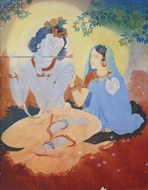![]() Modern & Contemporary Indian Art
Modern & Contemporary Indian Art
![]() Modern & Contemporary Indian Art
ASIT KUMAR HALDAR (1890 - 1964)
Modern & Contemporary Indian Art
ASIT KUMAR HALDAR (1890 - 1964)
RELATED LOTS
CONTACT US
Catalogue & Viewing
Lot Closed
Accounts & Shipping
Lot Closed
-
Literature
 Literature
Literature

An elegant piece of Tempera and Wash on Paper by Asit Kumar Haldar, one of the distinguished exponents of the Bengal Renaissance and the grand-nephew of Rabindranath Tagore (his maternal grandmother was the sister of Rabindranath). Haldar was born in the Tagore ancestral home of Jorasanko and over the years was often exposed to the coveted intelligentsia who graced the household. Born into a family of artists, he pursued his education at the Government School of Art, Calcutta under the guidance of revered artists like Jadu Pal, Bakkeswar Pal and Leonard Jennings. From 1911 to 1915 he was an art teacher at Shantiniketan and later the Principal of Government Art College in Lucknow.
In 1923 Haldar made a tour of Europe in 1923 and soon realized that Realism in European art had numerous limitations and instead sought to balance physical attributes in proportion to the magnitude of the subject matter. His stint between 1909-11 under the guidance of Lady Herringham (a virtuoso on Classical Indian Art) and later again in 1921 to study the murals of Ajanta and Bagh caves, came to his aid in defining a new visual language, that rose like a phoenix from the ashes of his indigenous heritage in contrast to a blindfold aping of western pictorial norms, that he felt, lacked the true spirit of India. The resultant effect was a lyrical style of representation with stylised elongated limbs as seen in the works of the Renaissance master El Greco. This mode of figuration over the years became the discerning identity of the Bengal school.
Haldar himself was extremely well-read literati and based many of his works on celebrated fictional poetry and prose. In the present Untitled Lot he depicts a pensive banjaran or gypsy girl of central India as is evident for her flowing colourful garment and silver jewellery. The setting is that of idyllic contemplation that draws its spectators into a meditative silence. The composition is expertly laid out with the maximum use of pictorial space with mild suggestion of perspective laid out by the gradually diminishing intensity of colour from forefront of the image to the background with a stunning command of the wash technique. The placing of the bright ochre coloured odhini around the figure further complements to the lyrical quality of thework.
Haldar was the first Indian to be elected Fellow of the Royal Society of Arts, London. In his book Ravitirthe he has acknowledged his debt to Rabindranath Tagore and Santiniketan in helping to establish him as an artist.


